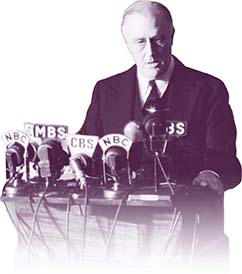SECTION 3: America Enters the War

▲ President Roosevelt addresses Americans after the attack on Pearl Harbor
WITNESS HISTORY  AUDIO
AUDIO
A Date Which Will Live in Infamy
In December 1941, the Japanese mounted a surprise attack on the U.S. naval base at Pearl Harbor, Hawaii. The next day Franklin Delano Roosevelt spoke to the shocked American public:
“Yesterday, December 7, 1941—a date which will live in infamy—the United States of America was suddenly and deliberately attacked by naval and air forces of the Empire of Japan…. The facts of yesterday speak for themselves. The people of the United States have already formed their opinions and well understand the implications to the very life and safety of our nation…. No matter how long it may take us to overcome this premeditated invasion, the American people in their righteous might will win through to absolute victory.”
—Franklin Roosevelt, Message Asking for War Against Japan, December 8, 1941
Objectives
- Explain why Japan decided to attack Pearl Harbor, and describe the attack itself.
- Outline how the United States mobilized for war after the attack on Pearl Harbor.
- Summarize the course of the war in the Pacific through the summer of 1942.
Terms and People
- Hideki Tojo
- Pearl Harbor
- WAC
- Douglas MacArthur
- Bataan Death March
- Battle of Coral Sea
NoteTaking
Reading Skill: Identify Causes and Effects As you read, record the causes and effects of the attack on Pearl Harbor, as well as details about the attack itself, in a chart like the one below.

Why It Matters In the beginning of December 1941, the United States had engaged in warlike activity but had yet to commit itself. A surprise attack on Pearl Harbor, an American naval base in Hawaii, ended all debate and brought the United States into the war. The participation of the United States in this war, as in World War I, would decide the struggle’s conclusion. Section Focus Question: How did the United States react to the Japanese attack on Pearl Harbor?
Japan Attacks the United States
Although Japan and the United States had been allies in World War I, conflict over power in Asia and the Pacific had been brewing between the two nations for decades prior to 1941. Japan, as the area’s industrial and economic leader, resented any threats to its authority in the region. America’s presence in Guam and the Philippines and its support of China posed such a threat. Yet Japan relied on trade with the United States to supply much-needed natural resources.
Trouble in the Pacific
As war broke out in Europe, the Japanese Empire continued to grow in China and began to move into Indochina. President Roosevelt tried to stop this expansion, in July of 1940, by placing an embargo on important naval and aviation supplies to Japan, such as oil, iron ore, fuel, steel, and rubber. After Japan signed the Tripartite Pact in 1940 with Germany and Italy, FDR instituted a more extensive embargo. The embargo slowed, but did not stop, Japanese expansion as the Japanese were able to secure the resources they needed within their new possessions.




